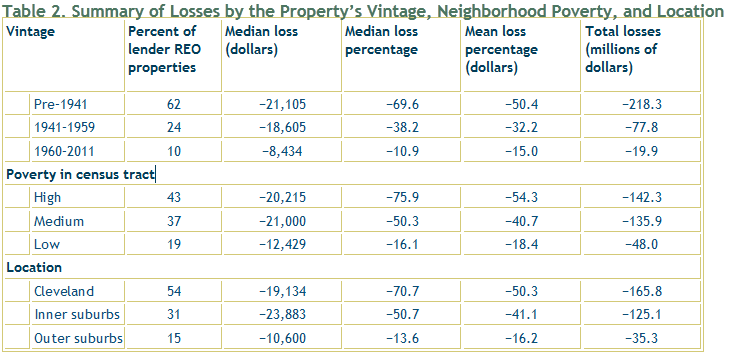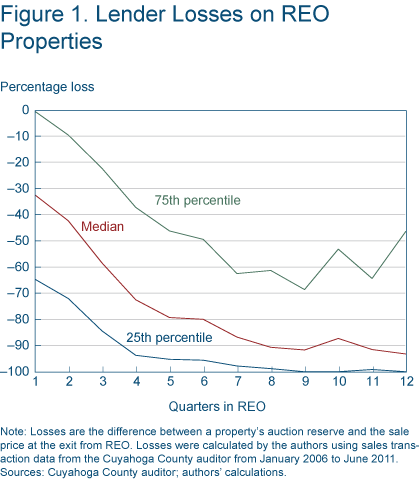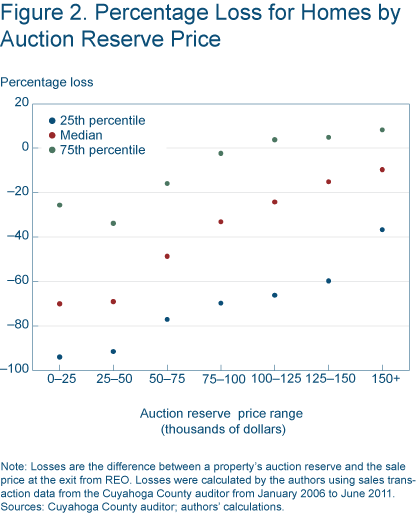Thomas J. Fitzpatrick IV and Stephan Whitaker
Swelling REO inventories are the latest fallout of the housing crisis, costing lenders money and contributing to neighborhood blight. Yet lenders could avoid taking on so much REO if they could more accurately estimate the value of the homes they foreclose on, especially in weak housing markets. Correcting this apparent misunderstanding of the market could speed the clearing of REO inventories, save lenders money, and help stabilize housing markets.
Because foreclosure rates have been elevated for so long and housing demand has been weak, the number of properties repossessed by lenders has ballooned. The growth of these real-estate-owned (REO) inventories has shifted much of the national policy focus from preventing foreclosure to shedding REO inventory.
As REO inventories grow, a number of problems grow with them. For one thing, property sitting in REO is expensive for lenders. Lenders must keep their REO properties secure, bring them up to local housing codes, maintain them, pay property taxes, and market them for resale. Meanwhile, neighborhoods wrestle with increased vacancy and its consequences, as the vast majority of REO properties are vacant.
These problems are worse in weak housing markets, where the supply of housing exceeds the demand for it. Several factors combine to increase the odds that REO homes will actually cost more to maintain than lenders can expect to sell them for. For example, carrying costs are likely to be higher. Homes entering foreclosure and lingering in REO in weak markets tend to be older and of lower quality than homes entering REO in strong markets. Property in weak markets is more likely to be vandalized while sitting in REO, and older housing stock tends to deteriorate more rapidly. To top it off, weak demand for housing depresses overall housing prices.
In weak markets, lenders may be better served by not taking properties into REO in the first place, or minimizing the time properties spend in REO by donating them to land banks (see “How Modern Land Banking Can Be Used to Solve REO Acquisition Problems” in the Recommended Reading).
Why this is not occurring more often may be explained by the systematic overestimation of property values in weak housing markets by appraisers, investors, and lenders. Overestimating the value of a foreclosed home leads lenders to set too high a minimum bid at the sheriff’s sale, which lowers the chance that someone will buy the home at the auction and take it off the lender’s hands.
We analyzed sales data from Cuyahoga County, Ohio, and found signs that appraisers, lenders, and investors could be routinely overestimating the property values of foreclosed homes there. We suggest some simple identifiers that can help lenders better estimate home values in weak housing markets. And though we have focused on one county, we believe the situation could be the same in other places. The factors we identify as possible causes of overestimation in Cuyahoga County are likely to be found in many other weak housing markets around the country.
Estimated Property Values and the Reality Check
To investigate how accurately lenders are valuing properties prior to taking them into REO, we turned to a relatively weak housing market: Cuyahoga County, Ohio (home to Cleveland). We analyzed property transaction data from the county auditor from January 2006 to June 2011, comparing the auction price paid by the lender and the subsequent sale price of the home. If the sale price is less than the minimum that was set, we say the lender took a “loss.”
Ohio is a judicial foreclosure state, which means that once a property has been foreclosed upon, it is seized by the county sheriff and auctioned off. Once the property has been seized, the sheriff pays for appraisers to go out and value the property. By state law, the minimum bid (or auction reserve) at the first auction is set at two-thirds of the appraised price. If there are no bids at the first auction, the lender can set the minimum bid for subsequent auctions, which are held weekly, at any amount up to the amount of the unpaid loan. For example, if a borrower had $100,000 of loan principal outstanding at the time of foreclosure, the lender could set the minimum bid at $100,000 plus foreclosure costs.
In theory, the lender should be setting the minimum bid based upon what it could obtain by selling the property, less carrying and transaction costs. Lenders typically obtain a real estate broker’s price opinion or a “walk around” appraisal, and then they calculate expected costs and value the property accordingly. In Cuyahoga County, it is unclear if lenders are relying on the foreclosure appraisal or if they are obtaining additional valuations of the property. If no buyer, including the lender, offers the minimum bid at the auction, the property is re-auctioned the following week.
Table 1 summarizes the losses that lenders appear to take in the data we analyzed. Lenders’ losses are compared to the losses taken by other major participants in sheriff’s sales: investors and federal agencies such as Fannie Mae, Freddie Mac, and the Federal Housing Administration. Most major participants are either lenders who hold the mortgages and take ownership of property that is not purchased at auction, or investors who purchase property at auction.
Note: Losses are the difference between a property’s auction reserve and the sale price at the exit from REO. Losses were calculated by the authors using sales transaction data from the Cuyahoga County auditor from January 2006 to June 2011.
Sources: Cuyahoga County auditor; authors’ calculations.
Purchasers of property at Cuyahoga County foreclosure auctions tend to resell the property for less than they paid. Investors tend to do the best, selling properties for an average of 26.5 percent less than they paid at auction. Federal agencies do worse on average than investors, but better than lenders, selling properties out of REO for about 30 percent less than their auction reserves. Lenders tend to sell property out of REO for 42 percent less than the auction price.
Figure 1 charts the losses over the time properties spend in REO. Among homes sold after one year in REO, the losses are very high. At least a quarter of the long-held properties are complete losses, as indicated by the 25th percentile trend dropping below 90 percent. Even the “better” REO sales after a year, around the 75th percentile, are taking losses of 60 percent from the auction reserve. If a home sells after five quarters in REO, the median loss taken by lenders is roughly 80 percent of the auction price.
There are three forces that very likely combine to create the trend of higher losses the longer properties stay in REO. First, the higher-quality REO properties in any price range exit REO within the first few months. Those that take longer to sell are probably the ones that were in relatively poor condition when repossessed. Second, the homes may be rapidly deteriorating while the lenders own them. The lower-value homes in distressed neighborhoods are often vandalized and stripped of metals. Despite winterization, homes may suffer weather-related damage without an attentive occupant to immediately address problems when they arise. A third, potentially contributing factor, is any downward trend in home prices that occurs while homes sit in REO. Certainly, such a trend occurred in Cuyahoga County over the period we studied, owing to the growing supply of REO and recently foreclosed homes, along with weakening demand for property in distressed areas. In any case, what lingers is worth far less than the price the lender pays at auction.
Lenders might be overvaluing property in weak housing markets because they are using a uniform process that works well in most areas. For example, a drive-by appraisal of new housing stock is more likely to produce an accurate market price than it would for older, distressed housing stock. With few exceptions, newer homes will be in good condition inside and out. However, the age distribution of REO homes in weak markets is much older than most of the housing stock in the United States. In the Cuyahoga data, 86 percent of the homes in REO are at least a half-century old. Over the decades, some older homes were well maintained and others were neglected, leading to a very wide range of conditions and values.
The inaccuracies may also be due to appraisers or brokers not having enough comparable arms-length property sales (regular market-based sales) in extremely distressed markets, where most sales in the last five years have involved recent foreclosures. Looking to older arms-length sales at stale prices for a drive-by appraisal or broker price opinion may also overestimate the sale price in these markets.
Some Simple Ways to Improve Accuracy
A sorting out of REO properties is bound to happen because lenders do not have perfect information about their collateral to assign the perfect reserve price. However, dividing up the data suggests that the issue is not inadequate inspections of individual homes, but possibly misunderstanding entire market segments. We can observe that auction prices are much closer to the eventual sales prices in the part of the market that is closer to “normal.”
Nationally and regionally, the bulk of arms-length home sale prices exceed $100,000. As seen in figure 2, for homes with auction prices over $100,000, the auction price is close to the eventual sale price in at least half of the instances. For homes with reserves below $50,000 (57 percent of the REO inventory), the auction prices are substantially above what the house is eventually sold for. One possible reason for this systemic bias in auction prices in the below-$50,000 market segment is that lenders are calibrating valuation methods based on normal markets, not recognizing the unique situation of inflated appraisal values in the areas where most of their foreclosures have occurred.
The gap between the lender’s auction reserve and the price received for selling the property out of REO seems to vary with a few easily observed characteristics. The age of the home being auctioned off contains a lot of information that lenders may find useful to incorporate into their auction reserve calculations. As mentioned above, older housing deteriorates more rapidly than new housing and may be concentrated in less desirable neighborhoods. Table 2 shows lenders’ losses by the age of the home. While the method used by lenders to value property seems to be fairly accurate for newer homes, it again appears to grossly overestimate the value of homes constructed before 1941.
Neither the appraised value nor the lender’s auction reserve seems to be factoring in the property’s location. Table 2 contains lenders’ losses by location of the property. Again, the method used by lenders to determine property values seems relatively accurate for properties located in either low-poverty census tracts or in the outer ring suburbs of Cuyahoga County, while auction reserves seem to be set too high in medium- and high-poverty census tracts and in Cleveland or Cuyahoga County’s inner-ring suburbs.

Notes: Losses are the difference between a property’s auction reserve and the sale price at the exit from REO. Losses were calculated by the authors using sales transaction data from January 2006 to June 2011. The tract poverty level is estimated by the Census Bureau using the 2005–2009 American Community Surveys.
Sources: Cuyahoga County auditor; Census Bureau; authors’ calculations.
Lenders do not seem to be consistently refining their methods for estimating the value of homes in weak markets. Estimates seem to be improving for only the lowest-poverty areas. Figure 3 shows the losses taken by lenders based on the year the property was taken into REO and the poverty level of the neighborhood.
From 2007 to 2009, losses dropped across the board, which could reflect appraisals becoming more accurate. (However, these drops may also be explained by other factors, such as the first-time-homebuyer tax credit propping up housing demand in 2009 and 2010.) If the reduction in losses resulted from refining property-valuation techniques, losses should have remained the same or continued to shrink in 2010. It appears that the only area in which lenders are modifying their property-valuation techniques—either to lower auction reserves or foreclose more selectively—are the high-poverty areas of Cuyahoga County. In medium- and low-poverty areas, losses shot up in 2010.
Data for 2010 is not complete. The calculations for figure 3 are based on homes that exit REO within two years, and we have not yet observed two years of sales for all of the homes foreclosed in 2010. Updating these calculations will include the lower-quality properties that take longer to sell, thereby increasing the estimated losses on 2010 foreclosures.
Policy Implications
There are three reasons lenders may be overvaluing foreclosed properties. The first is that they may not actually be overvaluing property at all, but rather placing the minimum bid knowing the property is not worth it. Anecdotally, some lenders report placing the minimum bid just to obtain control of the property, even when they know it is worth less. However, it is unclear why lenders would want control of these properties.
On one hand, lenders might want to gain control at the auction to get higher prices for the home later. Buyers should pay more for REO homes, which they can inspect, than they would for a home at a sheriff’s sale, where inspections are limited or impossible. Bidding on a home without inspecting it is risky, and the prices would have to be very low to entice bidders. Collecting the higher sale price after buyers inspect the property could justify setting auction reserve prices higher.
On the other hand, this strategy can work in the opposite direction. If a home is found to be uninhabitable and beyond repair after the sheriff’s sale, the lender has foregone any proceeds from another bidder. Many of the REO homes eventually sell for prices so low that the proceeds would barely cover the maintenance and transaction expenses. If the lenders lowered the auction reserve to these prices, the same buyers might take more of the homes at the sheriff’s sale, and the lender would not incur the expenses.
Lenders may be overvaluing properties because their valuation methods—which they use because they work well in most markets—don’t happen to work well in weak ones. The evidence supports this explanation, since it is not only lenders that overestimate the value of properties acquired in the sheriff’s sale, but all parties, including federal agencies and investors. Proper valuation methods would substantially discount the appraised value of homes in weak markets, bringing the estimates of value more in line with what the property will sell for on the open market. It is important to remember that lenders usually cannot legally enter the home and inspect the interior prior to foreclosure, which would prevent them from detecting hidden defects. But even when they are allowed to inspect the interior, it may not be feasible to inspect each property prior to foreclosure, given the number of foreclosures initiated every year.
Finally, there may be incentives that encourage lenders to overvalue foreclosed properties. Doing so would allow them to shift accounting losses from their loan portfolio to their REO portfolio. Solvency tests and supervisors of financial institutions place less emphasis on REO portfolios than on loan portfolios. This is a function of banks having relatively small REO portfolios in normal times, but always having an active loan portfolio that can be analyzed.
Regardless of why it is occurring, correcting the systematic overestimation of property values in weak housing markets appears to be relatively simple and has large potential ramifications. Our analysis suggests that if lenders place more weight on simple property characteristics—the age of the home and its location—in their value estimates, they will more accurately price property in weak housing markets.
More accurate pricing could lower REO carrying costs in a few ways. As discussed above, lenders could avoid taking on REO altogether by setting their auction reserves lower and allowing others to purchase more properties at auction. Additionally, more accurate prices might help lenders reduce the number of foreclosures they initiate by making more loan modifications look sensible. The more successful loan modifications the lender initiates, the fewer homes thethat will end up in REO, and the lower the lender’s carrying costs will be. But if lenders are overestimating the value of weak-market property at foreclosure, then they are likely overestimating the value of the same property when determining whether to offer loan modifications through their net present-value calculations. If the current value of the property is overestimated, it is less likely that a loan modification will be offered, and when one is offered, it will be less generous than if the property’s value is not overestimated.
Another way in which more accurate pricing could lower carrying costs is by helping lenders identify the properties that have the least value early in the foreclosure process. Knowing which properties aren’t worth holding onto will facilitate their disposition to land banks, local governments, or community development corporations seeking to remediate blight. The Cuyahoga County Land Bank, for example, takes low-value REO property in exchange for contributions towards demolition costs. Transferring REO property to organizations dedicated to disposing of it lowers lenders’ carrying costs for distressed properties that could have lingered in REO, hastens blight removal, and helps stabilize distressed housing markets.
Source:
Overvaluing Residential Properties and the Growing Glut of REO
Cleveland Fed, March 15, 2012






What's been said:
Discussions found on the web: